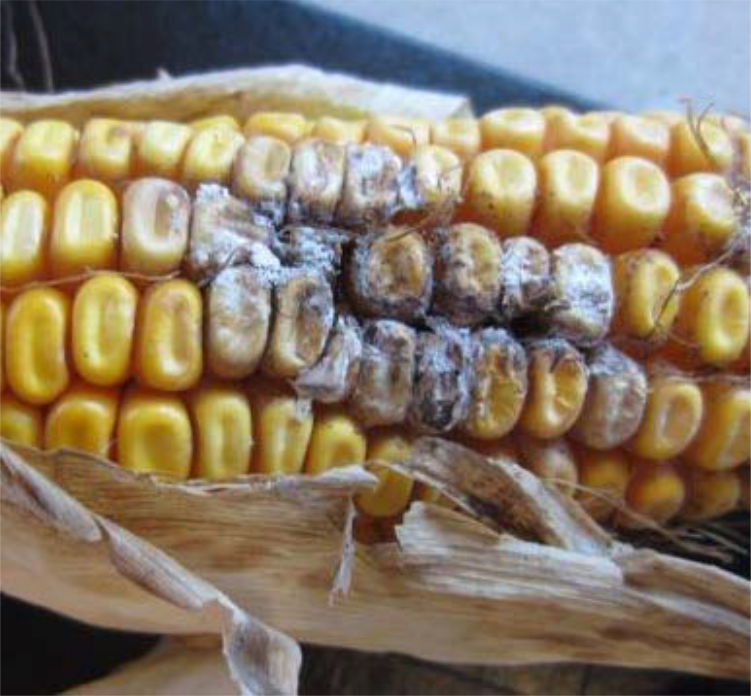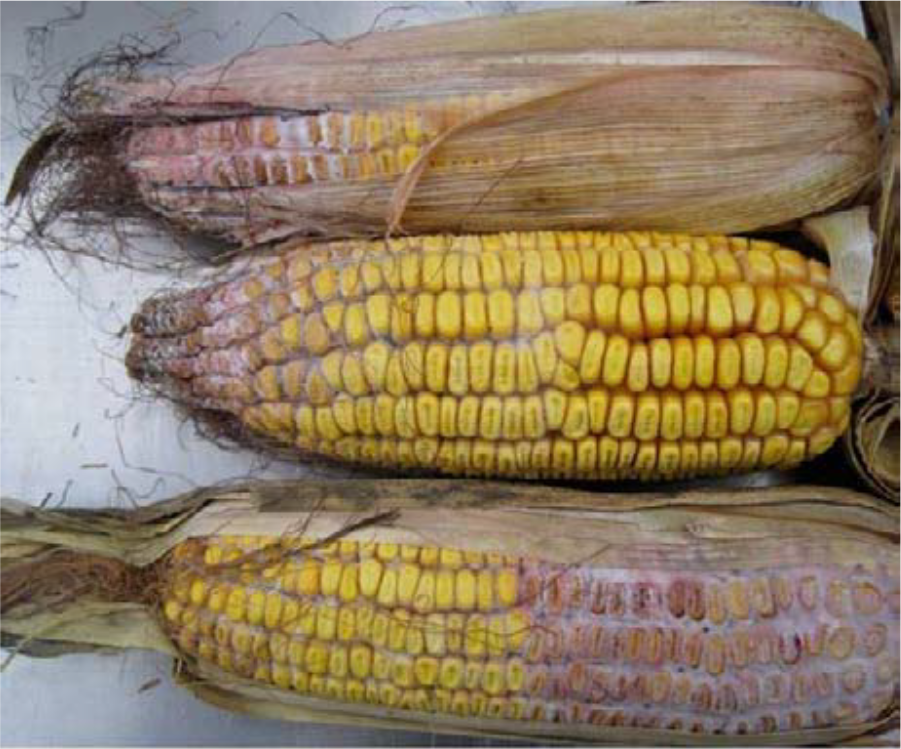⇦ Back to Livestock and Feedstuff Management Home
¶ Introduction
“Mycotoxins” are natural chemicals produced by certain fungi, many that produce molds. Mycotoxins can affect human or animal health if they consume contaminated food or feed. There are currently 400 to 500 known mycotoxins, each produced by a different mold.
¶ A. What is “vomitoxin”?
- Common name for deoxynivalenol (DON) 2. Produced by Fusarium and GIbberella fungi
- Fusarium graminearum is most notable for DON production
- Responsible for head blight or “scab” disease of wheat
- Responsible for “red ear rot” in corn
- Fusarium graminearum is most notable for DON production
- Molds can proliferate before harvest, but continue to grow postharvest
¶ B. Vomitoxin (DON) advisory levels
- Advisory levels differ from action levels
- Provide an adequate margin of safety to protect human and animal health
- Grain and products exceeding advisory levels are not subject to reporting or seizure
- Guidance for rations based on maximum amount of infected grain or grain products as percentage of total ration
¶ C. Conditions favoring vomitoxin production
- Mycotoxins may or may not be present if visible molds are present
- Absence of visible mold does not guarantee absence of mycotoxins
- Fusarium molds
- Are associated with ear rots and stalk rots
- Develop under wide range of environmental conditions
- Can infect seedlings and developing kernels
- Affected kernels may appear purple, tan, or brown ii. Visible mold appears white to pink or salmoncolored
- Wheat
- Excessive moisture at flowering and early grainfill stages
- Warm, wet weather at harvest
- Corn
- Cool, wet growing season
- Also, dry conditions in midseason followed by wet weather
- Insect or hail damage to ears
- Warm, wet weather at harvest
- Infection usually has minimal effect on yield
- Cool, wet growing season
- Gibberella molds
- Responsible for Gibberella ear rot
- Pinkish mold; usually begins at ear tip
- Produces both DON and zearalenone
- Overwinters on corn and small grain residue
- Produces spores ii. Can infect soybean roots
- Spores infect corn during silking
- More prevalent when:
- rotation is continuous corn ii. wheat is affected by Fusarium head blight iii. cool, wet weather occurs during early silking iv. fall rains delay harvest
- Responsible for Gibberella ear rot
¶ Figure 1. Ears With Fusarium Ear Rot

¶ D. Vomitoxin effects
- Mycotoxins can interact to produce symptoms different or more severe than expected
- Pure DON added to diets, does not have as much toxicity as do feeds contaminated with DON
- Due to the presence of multiple mycotoxins in naturally contaminated feeds?
- Fusaric acid interacts with DON to cause vomiting effects
- Was originally attributed to DON alone
- Resulted in use of name “vomitoxin” for DON
- Processing can reduce, but not eliminate DON
- e.g. contaminated wheat grain processed into flour
- Over 0.6 to 1.0 ppm in total ration dry matter
- Feed refusals
- Reduced growth, weight loss,
- Sometimes diarrhea
- 15 ppm or above
- Vomiting
- Reproductive failure
- Death
- Dairy cattle disorders
- Generally associated with poor performance
- 1.5‐2.5 ppm in total ration dry matter or possibly lower
- Off‐feed
- Ketosis
- Altered rumen fermentation
- Displaced abomasum v. Distinct milk decrease
- Sometimes diarrhea
¶ Figure 2. Corn Ears With Gibberella Ear Rot

¶ E. Sampling and analysis for vomitoxin
- Survey fields before harvest
- From dent through to harvest, check five to ten field locations
- Target areas with plants that appear most stressed.
- Peel back the husks of 10 ears at each location and inspect for mold
- Suggested sampling procedures
- Standing grain: Collect 25 ears or heads at random throughout the field
- Grain cart/truck: Take multiple probes for a composite 10 lb. sample
- Moving grain stream: Take a composite 10‐lb sample consisting of 12 to 20 subsamples from the grain stream
- Keep samples cool, but do not freeze
- Ship promptly, early in the week, to avoid weekend delays
- Analytical methods
- Enzyme‐linked immunosorbent assay (ELISA)
- Coupling reaction between specific mycotoxin and antibodies specific for that mycotoxin
- Test kit: screening test to provide yes/no answer iii. Test kit with reader: provides quantitative data
- High performance liquid chromatography (HPLC)
- More sensitive; provides quantitative data at lower detection limits than ELISA
- Requires more time; more expensive
- Enzyme‐linked immunosorbent assay (ELISA)
¶ Table 2. FDA Advisory Levels for Vomitoxin (DON) in Various Commodities (On Dry Matter Basis) |
|||
| Single ingredient concentration | Maximum in complete diet | Complete diet concentration | |
| GRAINS and GRAIN PRODUCTS intended for: | |||
| Beef or feedlot cattle, older than 4 months | 10 ppm | ---- | 10 ppm |
| Dairy cattle, older than 4 months | 10 ppm | 50% | 10 ppm |
| Swine | 5 ppm | 20% | 1 ppm |
| Chickens | 10 ppm | 50% | 5 ppm |
| All other animals | 5 ppm | 40% | 2 ppm |
| DISTILLERS GRAIN, BREWERS GRAINS, GLUTEN FEEDS, and GLUTEN MEAL intended for: | |||
| Beef cattle, older than 4 months | 30 ppm | ---- | 10 ppm |
| Dairy cattle, older than 4 months | 30 ppm | ---- | 5 ppm |
| WHEAT and WHEAT PRODUCTS intended for human consumption: | |||
| Grain | n/a | ---- | ---- |
| Finished products (e.g., flour, bran, germ) | 1 ppm | ---- | ---- |
| *Complete diet includes grains, all grain by‐products including distillers and brewers grains, hay, silage, and roughage. | |||
¶ References
Adams, R.S. et. al. Mold and mycotoxin problems in livestock feeding. DAS 93‐21. Penn. State Univ. Coop. Ext. Svc. 17 pg. http://www.das.psu.edu/researchextension/dairy/nutrition/pdf/mold.pdf/view?searchterm=mycotoxin
Corn Protection Network. 2016. Ear Rots. http://cropprotectionnetwork.org/corn/earrots/ accessed 13Sep2017
Hurburgh, C.R. Mycotoxins in the Grain Market. Integrated Crop Mgmt. News. Iowa State University Extension. http://www.extension.iastate.edu/Grain/Topics/MycotoxinsintheGrainMarket.htm accessed 11/1/2009
National Feed and Grain Assn. 2016. NFGA Alert: Mycotoxins. https://imis.ngfa.org/images/uploads/NGFA‐Alert‐Mycotoxins‐Sept282016‐FINAL.pdf accessed 11/18/2019.